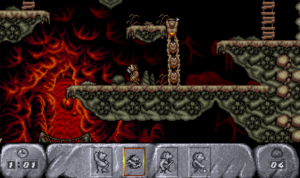The Humans as Lemmings Clone
There should be a name for works that imitate another work but completely miss the point, taking the superficial details while leaving out the basis of the original’s appeal. As Sleepwalker is to Sandman, as Ai Yori Aoshi is to Love Hina, as most bad fantasy novels are to Lord of the Rings, so The Humans is to Lemmings.
To someone looking at The Humans for the first time today, it may not be clear that it’s a Lemmings imitation. It was very clear in 1992. Lemmings was in the ascendant, and would be on the mind of anyone making (or purchasing) a level-based puzzle game with a 2D side view. Add to that the “save the tribe” aspect, the control over multiple identical and undifferentiated beings, the puzzles based around sacrificing some of your guys to save the rest, the music — ye gods, the music. Lemmings had this gloriously cheesy pop music that would be embarrassing in any other context, but seemed like just part of the fun there. The Humans does something similar, but with more of a cartoon caveman style, which is to say, a boogie beat and an emphasis on simple percussion such as hand drums and xylophones (or synthesized approximations thereof). It’s odd that this style says “cartoon caveman” so strongly, especially since our most culturally prominent caveman cartoon, The Flintstones, doesn’t use it at all, but there it is.
It also plays a lot like Lemmings overall, and not just in good ways. Most of the time, your attention is on the problem of getting multiple beings from point A to point B. Doing this usually involves multiple stages, where each stage is an opportunity to screw up. When you do so, you have no choice but to start over from the beginning: there are no save points within levels. So on the tougher levels, you wind up repeating the earlier stages a lot — a common pattern in action games, but not so much in puzzle games, where the pleasure is in figuring things out. But it serves to pad out the time required to play it to completion. Even worse, both games feature time limits on levels. While this can be part of the puzzle, challenging you to figure out how to complete your objectives as efficiently as possible, mostly it’s just a way to make sure that you don’t complete a level successfully on your first try, even if you don’t do anything wrong.
One of the more overlooked innovations of Lemmings is that it was one of the first games to figure out how to take advantage of the mouse in a realtime context. There had been games that used on-screen buttons to awkwardly give the player’s avatar orders at one remove, and there had been games that used the mouse to control the player’s avatar directly as a kind of joystick substitute, but the makers of Lemmings were clever enough to realize that the very concept of “player’s avatar” was an unnecessary assumption, a by-product of joystick-centric gameplay that a mouse-based game could do without. Instead, it took an approach similar to what would later become the RTS genre. At no point in Lemmings did the player assume direct control over a lemming’s actions; you could switch them from one mode of activity to another, but they were fundamentally autonomous beings that would march ahead without instruction. The result was an active world, one where things were always happening, sometimes more things than the player could easily pay adequate attention to.
And this is the part that The Humans gets wrong. It’s still plugged into the joystick paradigm, giving you direct control of one human at a time while everyone else just stands there and waits. Actually, that’s not quite true: when you pick up a torch or a spear, you can switch to a mode where you stand there waving it to fend off enemies, and remain in this mode when you switch control to someone else. This is the most Lemmings-like of the actions you can perform, and has obvious precedent in the “Blocker” role from that game. It’s also the least-often-useful thing you can do with a spear or a torch. It’s understandable why they did it this way: they were aiming at console ports, something that Lemmings always did awkwardly, and heck, even on PCs, not everyone had a mouse back then. But the end result is the opposite of Lemmings‘ active world. It’s a passive world, one that’s reluctant to even shoot at you.
 Comments(0)
Comments(0)